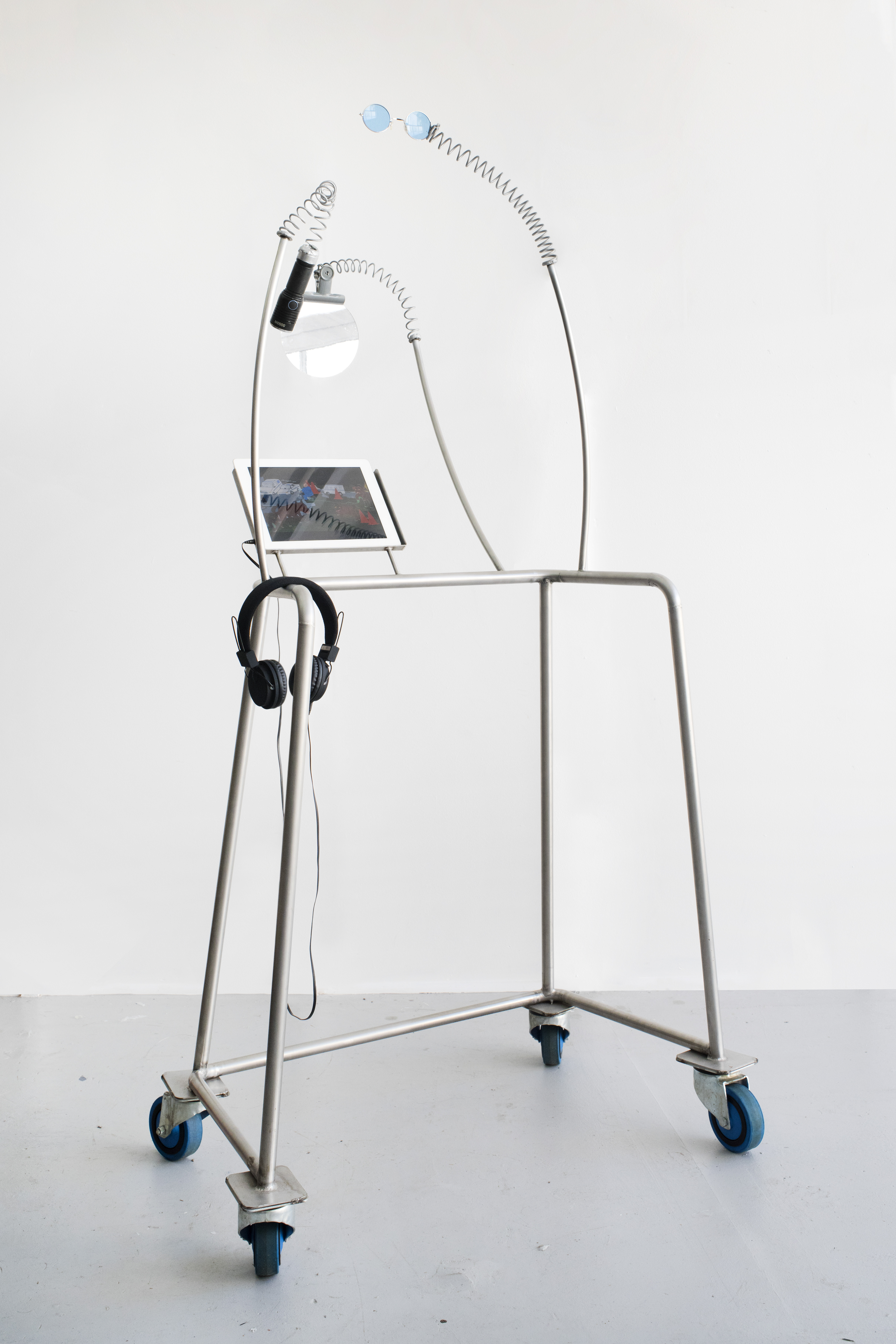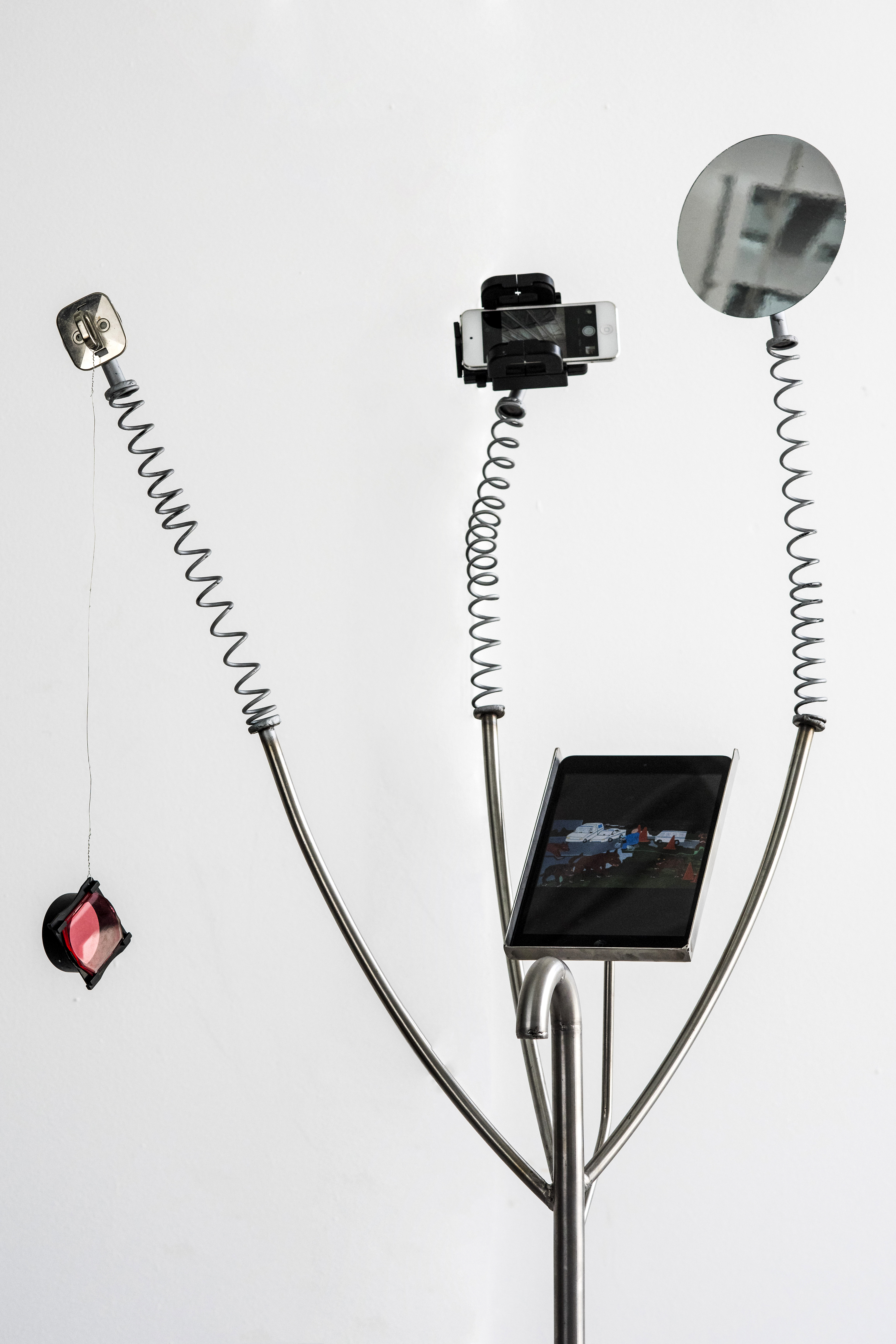An amalgamation of colour, image, sound and installation. An artist’s studio showcases a new body of work Trembling Thought presented by SMITH Studio. The meeting of traditional and non-traditional media. A world built from Katharien de Villiers’ memory and curated by her hand. As if walking on to an 80’s sci-fi film set. Small animals glare through luminous eye slits. The viewer is asked to engage with work through various entry points.
The expansive new body of work takes interest in uncertainty and virtual reality. The nucleus of Trembling Thought is that of the instability of memory. The show itself is described by the artist as “A recorded library of warped memory”.

Creating from her own memory, the unreliable nature of one’s own recollections is celebrated. In uncertainty, she finds multiplicity and potential. In Trembling Thought De Villiers acts in order to materialise both the desires and power structures prevalent in the reproduction of memory.
I spoke to the artist to reveal more about her process and thought behind the new body of work:
Process and the audience’s engagement/dissection of process is of prevalence in this body of work. Why is it so important?
As an artist, I have always been acutely aware of my disengagement from work by the time it is put on show for viewers. In this awareness I try to create spaces within which viewers can find their own entrance points in the work, allowing them to build a personal relationship with the work independent of my artistic intention, but within the spatial elements of my truth and curation.

In your artist bio it is stated that thinking is broader than the work itself. How do works and concepts correlate? Do they not carry the same amount of weight? Are artworks then a tool to access the thought conveyed?
Saying thinking is broader than the work itself is just another jab at the overwhelming process of creating works which can live beyond a singular intention. I wouldn’t call the work “tools”, since somehow that in itself designates purpose and outcome. The artworks serve as elements which can be placed in different relations to one another, form new combinations of thought and generate a multitude of rational conclusions. The works become to thought what letters are to words; when placed in new combinations meaning can be altered in the blink of an eye.
Is Virtual Reality employed as a way to speak about uncertainty?
The new understanding of virtual reality speaks of an artificiality which is not applicable to this body of work. This is a more personal version of virtual reality. Personal memories and first-hand experiences make up the content of “Trembling Thought”. It is the forced nature of the elements’ relationship in the works, the surreal scale and shifting perspectives that initiate the sense of uncertainty which ultimately guides the viewer through a trembling world of forced relations.

What is this potential that is found in uncertainty and warped memory?
Potential in as much as the outcome of thought in relation to the work is not designated or pre-destined. The viewers find themselves confronted with my memories, memories which have already started cross-breeding and hybridizing with other experiences and memories of my own. The potential and uncertainty exists in the very nature of these memories and memory’s natural inclination to bend, break and form new truths.
The new body of work has a self-reflexive quality. How do you think audience members will be able to identify with this personal project?
“Trembling Thought” expects a huge amount of engaging energy from the viewer. Through the process of curation, I wanted to amplify the feeling of a labyrinth, or that the viewer is in fact strolling through my mind. As an artist, I have never quite been able to create beyond personal experience. It would seem arbitrary to speak in a voice that isn’t my own. The viewers greatest power lies in their ability to respond to visual stimulus and relate from an individual perspective and personal archive of memory.

Please unpack what is meant by “…to materialise the desires and power structures at play while we reproduce memory.”? What are these power structures and desires and why and how would memory be reproduced?
Memory, in my opinion, has a morphing hierarchy, which is informed by desire. Desire is ultimately what drives memory to discard or accumulate. In a way memory’s ability to organically grow, shrink and generally change shape makes it its own reproductive system – I was simply the catalyst in the physical rendering of these thoughts.
Dualities seem to be of much importance. Could you please elaborate on this?
The doubling of elements (such as fat cops or snarling dogs) is a mental process of visualization. Repeating elements becomes a way of engaging with the hierarchy of memory and the potential of repeating elements in new combinations. Duality could of course also refer to both physical and emotive contrast in the works.

Does the work Kinetic Window attempt to make a commentary on the physicality of modern art and where it is found spatially?
‘Kinetic Window’ is an exploration of the Post-modern obsession with meaning and understanding in art. I often feel that viewers expect a conclusive emotional or intellectual understanding of art and the accompanying sound piece elaborates on this concern. It is problematic for viewers to expect understanding if they refuse to engage with works from their personal archive of knowledge.
Trembling Thought was presented as a one-night art event in the Artist’s studio showcasing an elaborate body of work. The show included new paintings and a number of moving installations as seen earlier this year at the Investec Cape Town Art Fair. The event took place on the 14th of June, however, the artist is available for studio visits in the month after the show to discuss her process and take collectors through her work.








